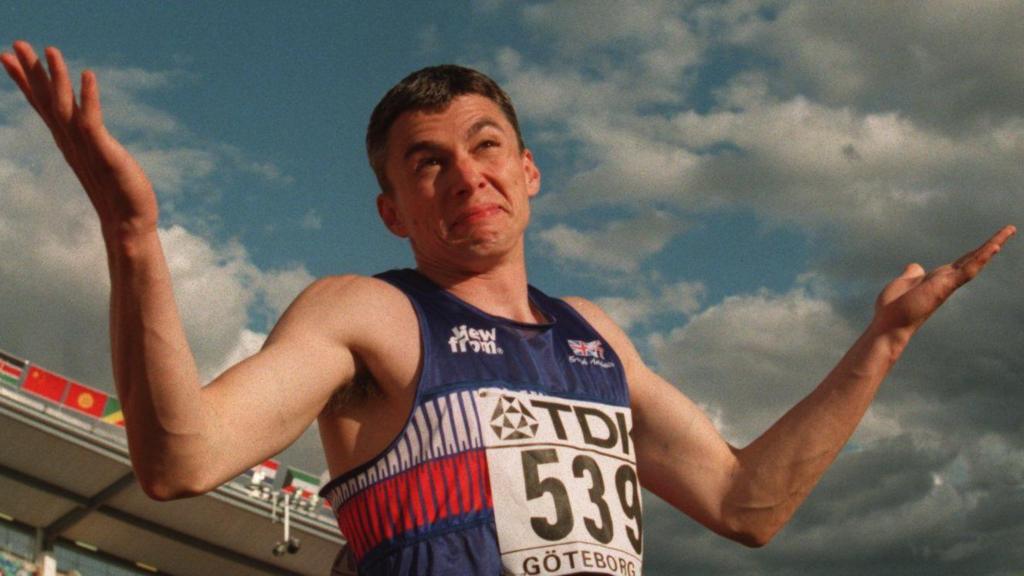This video can not be played
Edwards relives his triple jump world record 30 years on
“I don’t think it’s a good sign for athletics as a sport that you have a record that stands for 30 years.”
Jonathan Edwards’ pride in his triple jump world record is tempered with surprise that no athlete has surpassed the 18.29m mark he set on 7 August 1995 at the World Championships in Gothenburg.
“When you consider the advancements in sports science, nutrition, and training methodologies, it raises questions about the overall health and progress of the sport,” Edwards, Britain’s sole track and field world record holder in regularly contested events, told BBC Sport.
This perspective potentially downplays his own remarkable achievement, as only seven other men in history have exceeded the 18m mark.
However, if one adheres to the belief that records are meant to be broken, the longevity of this particular record invites scrutiny.
Hop, Step Jump: The Unbeatable Record
Record Breakers: Edwards and Cram
Jonathan Edwards is Britain’s only track and field world record holder in regularly contested events
Upon arriving at Gothenburg’s Ullevi Stadium, Edwards faced a landscape where no one had legally surpassed the 18-meter threshold in favorable wind conditions.
Within the first two rounds of the competition, he achieved this feat twice.
His opening-round jump of 18.16m saw him land beyond the measuring board, followed by an additional 13cm added to the record approximately 20 minutes later, solidifying one of British athletics’ most celebrated performances.
Edwards entered the competition as the world record holder, having jumped 17.98m to surpass American Willie Banks’ previous mark by one centimeter. He had also recorded the longest jump in history, albeit wind-assisted, at 18.43m.
He has characterized himself as a sprinter, rather than a jumper, and likened his contact with the ground through the hop-step-jump phases to a pebble skimming the water. Furthermore, his weight of 71kg was notably lighter than many other athletes.
That season, he modified his technique to incorporate a double arm action, which he credited with enhancing his balance throughout all phases of the jump.
Despite these factors, Edwards admitted to a lack of confidence, revealing that he purchased sunglasses at Gothenburg airport to conceal his apprehension from competitors during warm-ups.
However, his rivals perceived something quite different.
“During our training sessions, we meticulously studied Edwards’ videos day in and day out,” said Jerome Romain, bronze medallist in Gothenburg. “His accomplishments were truly remarkable.”
Silver medallist Brian Wellman attributed Edwards’ record to his exceptional efficiency as a triple jumper.
Edwards believes that a contributing factor to the longevity of his record is that athletics has not “kept pace with the professionalisation of sport”, resulting in talented young athletes opting for other sports with greater earning potential.
“The rewards offered in athletics are not on par with those in other sports,” he stated.
“Talented young individuals may not necessarily choose track and field, particularly field events, where the financial incentives are less substantial than those on the track.”
When four-time Olympic champion Michael Johnson launched Grand Slam Track this season, offering a top prize of $100,000 (£75,125) at each meet, the disciplines were limited to track races.
Investment in the sport has also been declining, with UK Sport reducing funding for athletics for the second consecutive Olympic cycle. Last year, it was announced that UK Athletics would receive 8% less funding for the 2028 Los Angeles Games compared to the Paris 2024 cycle.
Furthermore, England Athletics reports a decline in participation in track and field, with an increasing number of young athletes dropping out.
Three of the five longest-standing men’s world records in commonly contested events are in jumps: the high jump, long jump, and triple jump records, all set between 1991 and 1995.
Despite advancements in technology, including footwear, since then,
Edwards believes that the carbon fibre plates in contemporary running shoes may not provide the same benefits to jumpers as they do to runners, where records continue to be broken.
“I question whether a carbon fibre plate can withstand the intensity of the impact and offer any rebound, which appears to be the key factor in track events.
“Athletes are experiencing a spring effect, leading to faster times. However, the forces involved in triple jump, and even long jump and high jump, are so extreme that I doubt the trampoline effect has the same impact.”
Dr. Tom Allen, a sports engineering expert at Manchester Metropolitan University and University of Canterbury Visiting Erskine Fellow, concurs that while the shoes enhance running economy, their impact on jumping events is “likely to be small or negligible.”
The closest anyone has come to Edwards’ record was ten years ago, when American Christian Taylor jumped 18.21m.
This year’s world-leading distance is 17.80m, while the Olympic gold medal last year was won with 17.86m.
“He [Edwards] can rest easy for a while,” Romain said. “This is not an easy feat, I’m telling you.”
Edwards admits uncertainty about how he will feel if his record is broken.
“It’s been a part of me for so long,” said Edwards, whose record jump is memorialized in a mosaic in Ilfracombe, Devon, where he spent his teenage years. “Actually, it would be nice if it carried on.
“It would be quite a good funeral [if there was] something down the aisle – 18.29m.”

